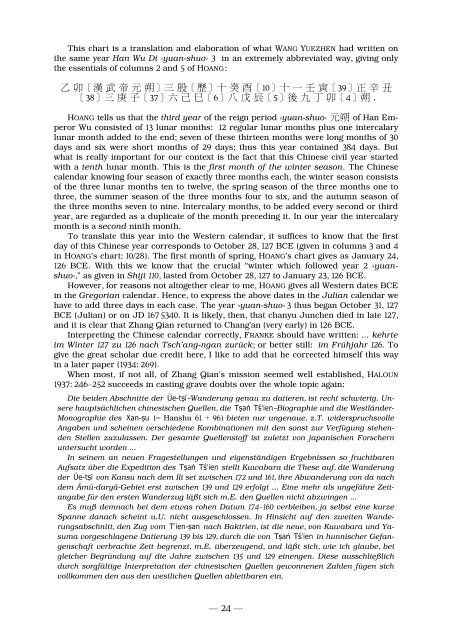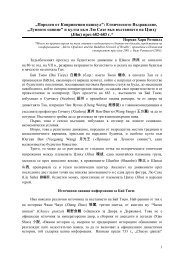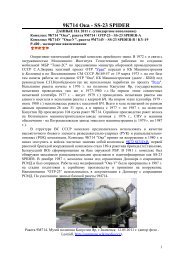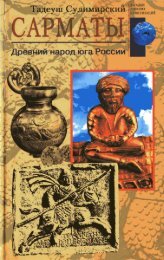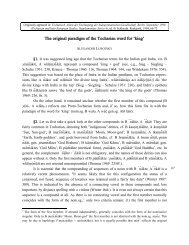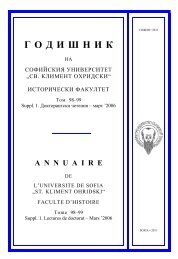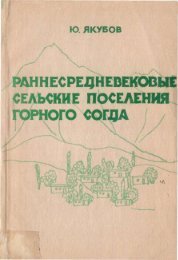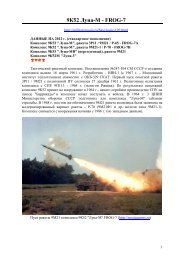You also want an ePaper? Increase the reach of your titles
YUMPU automatically turns print PDFs into web optimized ePapers that Google loves.
This chart is a translation and elaboration of what WANG YUEZHEN had written on<br />
the same year Han Wu Di ›yuan-shuo‹ 3 in an extremely abbreviated way, giving only<br />
the essentials of columns 2 and 5 of HOANG :<br />
乙 卯[漢 武 帝 元 朔]三 殷[歷]十 癸 酉[10]十 一 壬 寅[39]正 辛 丑<br />
[38]三 庚 子[37]六 己 巳[6]八 戊 辰[5]後 九 丁 卯[4]朔 .<br />
HOANG tells us that the third year of the reign period ›yuan- shuo‹ 元朔 of Han Em-<br />
peror Wu consisted<br />
of 13 lunar months: 12 regular lunar months<br />
plus on e intercalary lunar month added to the end; seven of these<br />
thirteen months were long months of 30<br />
days and six were short months<br />
of 29 day<br />
s; thus this year contained 384 days. But<br />
what is really important for our context is the<br />
fact that this Chinese civil year started<br />
with a tenth lunar<br />
month. This is the first month of the winter season. The Chinese<br />
calendar<br />
knowing four season of exactly three months each, the winter season consists<br />
of the three lunar months ten to twelve, the spring season of the three months one to<br />
three, the summer season of the three months four to six, and the autumn season of<br />
the three months seven to nine. Intercalary months, to be added every second or third<br />
year, are regarded as a duplicate of the month preceding it. In our year the intercalary<br />
month is a second ninth month.<br />
To translate this year into the Western calendar, it suffices to know that the first<br />
day of this Chinese year corresponds to October 28, 127 BCE (given in columns 3 and 4<br />
in HOANG’s chart: 10/28). The first month of spring, HOANG’s chart gives as January 24,<br />
126 BCE. With this we know that the crucial “winter which followed year 2 ›yuanshu<br />
o‹,”<br />
as given in Shiji 110, lasted from October 28, 127 to January 23, 126 BCE.<br />
However, for reasons not altogether clear to me, HOANG gives all Western dates BCE<br />
in the Gregorian calendar. Hence, to express the above dates in the Julian calendar we<br />
have to add three days in each case. The year ›yuan-shuo‹<br />
3 thus began October 31, 127<br />
BCE (Julian) or on JD 1675340. It is likely, then,<br />
that chanyu Junchen died in late 127,<br />
and it is clear that Zhang Qian returned to Chang’an<br />
(very early) in 126 BCE.<br />
Interpreting the Chinese calendar correctly, FRANKE should have written: ... kehrte<br />
im Winter 127 zu 126 nach Tsch’ang-ngan zurück;<br />
or better still: im Frühjahr 126. To<br />
give the great scholar due credit here, I like to add that he corrected himself this way<br />
in a later paper (1934: 269).<br />
When most, if not all, of Zhang Qian’s mission<br />
seemed well established, HALOUN<br />
1937: 246–252 succeeds in casting grave doubts over<br />
the whole topic again:<br />
Die beiden Abschnitte der Üe-tṣï–Wanderung genau<br />
zu datieren, ist recht schwierig. Unsere<br />
hauptsächlichen chinesischen Que llen , die Tṣa ṅ Tś’ien–Biographie und die Westländer-<br />
Monographie des Xan-ṣu (= Hans hu 61 + 96) bie ten nur ungenaue, z.T. widerspruchsvolle<br />
Angaben und scheinen verschiedene Kombinationen mit den sonst zur Verfügung stehenden<br />
Stellen zuzulassen. Der gesa mte Quellen stoff ist zuletzt von<br />
japanischen Forschern<br />
untersucht worden ...<br />
In seinem an neuen Fragestellungen und eigenständigen Ergebnissen<br />
so fruchtbaren<br />
Aufsatz über die Expedition des Tṣaṅ Tś’ien stellt Kuwabara die These auf, die Wanderung<br />
der Üe-tṣï von Kansu nach dem Ili s ei zwischen 172 und 161, ihre Abwanderung von da nach<br />
dem Âmû-daryâ-Gebiet erst zwisch en 139 und 129 erfolgt ... Eine mehr als ungefähre Zeitangabe<br />
für den ersten Wanderzug läßt sich m. E. den Quellen<br />
nicht abzwingen ...<br />
Es muß demnach bei dem etwa s rohen Datum 1 74–160 verbleiben, ja selbst eine kurze<br />
Spanne danach scheint u.U. nicht ausgeschlo<br />
ssen. In Hinsicht auf den zweiten Wanderungsabschnitt,<br />
den Zug vom T’ien- ṣa n nach Baktrien, ist die n eue,<br />
von Kuwabara und Yasuma<br />
vorgeschlagene Datierung 139 b is 129, durch die vo n Tṣaṅ Tś’ien<br />
in hunnischer Gefangenschaft<br />
verbrachte Zeit be grenzt , m.E. überzeuge nd, und l äßt sich, wie ich glaube, bei<br />
gleicher Begründung auf die Jahre zwischen<br />
135 und 129 einengen. Diese ausschließlich<br />
durch sorgfältige Interpretation der chinesischen<br />
Quellen gewonnenen Zahlen fügen sich<br />
vollkommen den aus den westlichen Quellen ableitbaren<br />
ein.<br />
— 24 —


